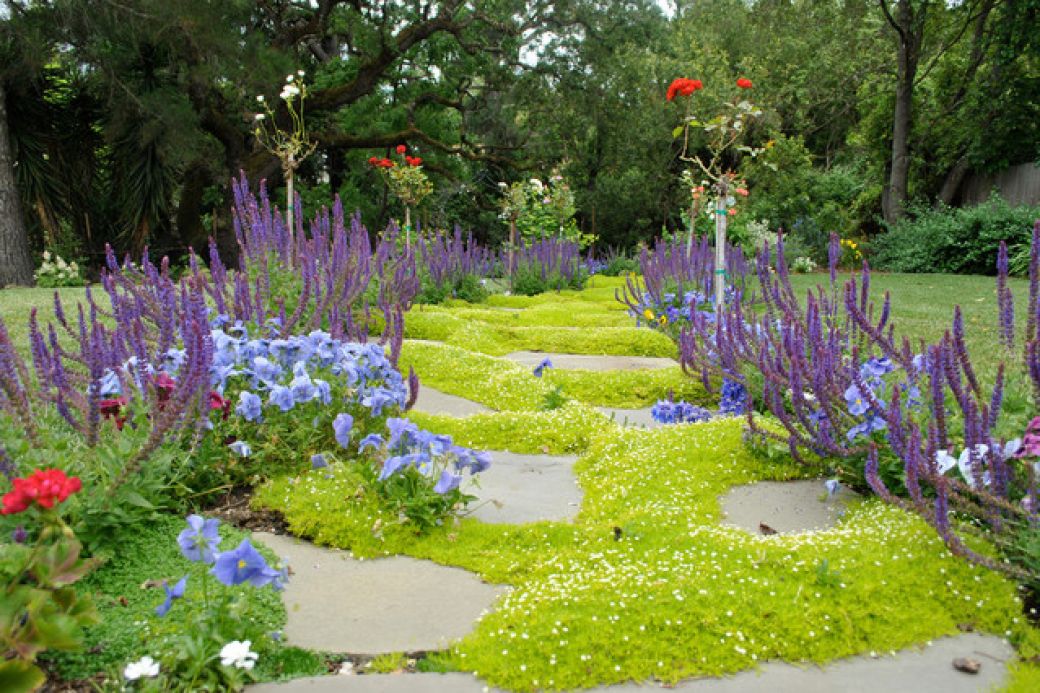Americans have long had a soft spot for lawns. Turf grass covers nearly 47 million acres in the U.S., according to the Lawn Institute. But there's plenty that's not green about all that green:
If you're looking for an alternative, consider replacing some or all of your high-maintenance turf with ground covers that form walkable "carpets," and innovative grasses that require little or no water or mowing once established.
In turn, you'll:
- Reduce the need for irrigation.
- Stop washing harmful chemicals into the watershed.
- Add depth and texture to your landscape.
- Spend your spare time enjoying your yard instead of manicuring it.
There's a ground cover to meet most needs, whether you're planting a pathway, a hedge, or a broad swath of green. They run the gamut of foliage textures and colors, and many have wonderful flowers. Some varieties are ground-hugging and feel delicious under bare feet. Others grow up to two feet tall, making them ideal as barriers or landscape punctuation.
Look for attributes that meet your needs: child-durable, deer-resistant, drought-tolerant, shade-loving. Mixing them up is not only aesthetically pleasing, it's also good for the landscape: Diversity increases resistance to pests and disease and reduces the need for fertilizer and pesticides. Here are some popular choices.
Creeping Perennials
Tight to the ground, these plants are especially good for cushy green carpets. They keep out weeds and allow air, water, and nutrients to get to plant roots. Many work equally well in rock gardens or in crevices between stepping stones, in full or partial sun. These include:
| Ground cover | Characteristic |
| New Zealand Brass Buttons (Cotula squalida) | Forms a mat. |
| Scotch or Irish Moss (Sagina subulata) | Not a moss at all, but a perennial that forms a cushiony blooming carpet. |
| Blue Star Creeper (Laurentia fluviatilis) | Has tiny green foliage, bear up to heavy foot traffic. |
| Creeping Jenny (Convolvulus arvensis) | Has an extensive root system that makes it quick to spread and tough to kill. That's OK if you're looking for tough, but a problem if it creeps where you don't want it. |
Besides being good creepers, many ground-hugging perennial herbs are often nicely scented, hardy under foot traffic, and even edible. These include:
| Ground cover | Characteristic |
| Chamomile (Chamaemelum nobile) | Has fern-like foliage and white flowers with yellow centers. |
| Corsican mint (Mentha requienii), | Thrives in shade, exudes a minty smell when trod upon, and is edible. |
| Various thymes (Woolly, Red, Prostrate) | Feature dainty flowers and work well between pavers or as a low mounding carpet. |
Creeping perennials cost $6 to $10 per plant. A 15-foot-by-20-foot area with plants two inches apart (for instant density) requires 300 plants. But if you're patient enough to wait a year or so for them to spread, you can buy fewer plants and space them 12 inches apart.
Clover
Although clover has gotten a bad rap as a weed, it's actually not a weed at all. In fact, a clover lawn (or, for high-traffic areas, a clover-grass mix) has many advantages. Sweet-scented, inexpensive, and quite durable, white clover (Trifolium repens) grows in any kind of soil, stays green even during low-water periods, and feels lovely underfoot.
Low-growing clover doesn't need regular cutting, nor does it need fertilizer, but an occasional mow will encourage new growth and discourage bees. If you don't mind the bees, consider letting your clover bloom, which benefits the bees and the environment.
Clover is an inexpensive ground cover option, costing under about $10 per pound. Clover seed coverage varies widely depending on the species of clover you choose and the supplier’s recommendations.
Related:
